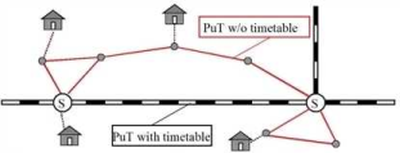To model PuT trips, Visum provides three types of PuT assignment procedures which differ in required input data, accuracy of results, and computing time.
- The transport system-based procedure, which is based on a PuT-specific "all or nothing" assignment, provides an overview of the transport demand structure. This procedure does not require a line network. For rough-cut planning purposes it helps to determine the "ideal line network" where each passenger chooses the fastest route in the network without any restrictions caused by PuT line routes or timetables (Transport system-based assignment).
- The headway-based procedure is ideal for urban networks with short headways and for long-term conceptual planning, as long as the timetable for the period being analyzed is still unknown. The headway-based procedure determines the transfer wait time at transfer stops from the mean headway of the succeeding lines. If necessary, co-ordination in the case of transfers between lines and also between the timetables of multiple lines are taken into consideration on sections with shared services, and then specified deviating transfer wait times are valid. Doing without the timetable on the level of individual trips ensures short computing times even for large networks (Headway-based assignment).
- The timetable-based procedure should be used if the PuT supply has long headways and coordination of the timetable is important for transfers. It takes the accurate timetable into consideration and is therefore particularly suitable for rural areas or train networks. There are two variants of the timetable-based procedure, which differ only in terms of the connection search procedure (Timetable-based assignment).
In large networks, a distinction can often be made between a main network, which is the most important one to be analyzed, and a subordinated network, which provides feeder functions for the main network. Examples for this are national rail networks with subordinated regional or urban bus networks, which also include cars or taxis for access and egress. For modeling the subordinated network, there are basically two alternatives.
- Traffic zones that are not served by the main network are nevertheless connected to stops of the main network by long connectors. This alternative means that planners are required to estimate the route choice in the subordinated network accurately when selecting and setting attributes for the connectors. The route choice can also change in the case of supply changes in the main network.
- With regard to modeling accuracy, it is instead recommended to also model the subordinated network as a PuT supply. In addition to the considerable effort required to obtain the timetable data, memory requirements and computing time for the assignment are also greater. Especially in the case of short headways in the subordinated network, the number of connections explodes.
A compromise solution involves modeling the entire main network and performing either a headway or a timetable-based assignment. The subordinated PuT supply in comparison is only modeled as a used link network and in the course of either the headway or timetable-based assignment it is treated as in the transport system-based procedure (best path search, see Image 146).

Image 146: Different modeling options for main and subordinated networks
For this kind of modeling, the used links and turns in the subordinated network are opened for transport systems of the special PuT-Aux type and provided with specific run times for these connections. If PuT auxiliary transport systems are not available for all demand segments (for example car for P+R access), this is expressed by targeted inclusion in the appropriate modes. The mode for the demand segment Employed with car contains the PuT auxiliary transport system P+R, but the demand segment Employed without car does not.
If the subordinated network is served by a line-based public transport system, but the timetable is not available, it is possible to store only the interval information within the timetable-based assignment for the public transport supply of individual lines (User Manual: Timetable-based assignment: Headway-based supply page). Time profiles and headways are then taken into account in the entire network. The run time of the assignment corresponds to that of a timetable-based assignment of the entire network.
The PuT assignment procedures are mainly used for the following applications.
- To determine volumes, for example line volumes, link volumes, and the number of passengers who board, transfer or alight at stops.
- To calculate passenger-specific PuT skims, for example journey time, number of transfers, service frequency.
- As a timetable information system which provides information on the departure and arrival times of individual connections.

